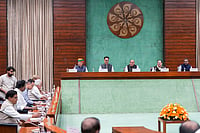In the rapidly evolving fields of 5G technology, smart grids, and sustainable Internet of Things (IoT) applications, the work of Mr. Shaman Bhat truly stands out. His research is helping shape the future of wireless communication, energy distribution, and environmental sustainability, providing a foundation for smarter, more resilient cities.
5G: The Next Frontier in Wireless Communication
5G technology is at the forefront of a technological shift. Mr. Bhat’s research is centered around harnessing this technology for applications that serve society in a way that is both beneficial and sustainable.
One of the key areas of Mr. Bhat’s research explores the use of 5G networks in robotic surgery, focusing on improving both security and reliability. In a recent paper, “Enhancing Security for Robot-Assisted Surgery through Advanced Authentication Mechanisms Over 5G Networks”, Mr.Bhat addresses the critical issue of securing the end-to-end information transfer between the surgeon's control console and the robotic system. The paper proposes an enhancement to the existing Transport Layer Security (TLS) protocol, integrating biometric and multi-factor authentication mechanisms. Through simulation and testing, the proposed solution proves effective in adding a robust layer of security without increasing latency or delaying data transmission—two critical factors for the success of robotic-assisted surgeries.
The societal benefits of this research are vast. For countries with limited access to specialized medical expertise, 5G-enabled remote surgeries can bridge the gap between urban and rural healthcare services. This technology reduces the need for costly patient transfers and enhances the quality of care in underserved regions. As a result, nations can provide equitable healthcare services, reduce healthcare costs, and improve patient outcomes on a large scale.
5G in Smart Grids: Powering the Future
Mr. Bhat’s research also delves into the potential of 5G for smart grids, which represent a fundamental shift in energy management. In a comprehensive paper, “Leveraging 5G Network Capabilities for Smart Grid Communication” he dives into the architecture of 5G networks and their potential to transform smart grid applications. As modern energy infrastructure becomes increasingly complex, the need for reliable, low-latency communication systems is critical. Bhat’s research focuses on the key 5G features—such as network slicing, massive MIMO (Multiple Input Multiple Output), and URLLC (Ultra-Reliable Low Latency Communication)—that can support the unique demands of smart grids. His analysis shows that 5G’s capabilities align well with the requirements of smart grids, allowing for real-time monitoring and efficient management of energy distribution. The paper also provides a deep dive into the design considerations, deployment strategies, and performance trade-offs involved in applying 5G to smart grids.
Sustainability Through IoT: A Connected Ecosystem
In another pivotal paper, “Strategic Integration of Predictive Maintenance Plans to Improve Operational Efficiency of Smart Grids” presented at the IEEE International Conference on Information Technology, Electronics and Intelligent Communication Systems, Bhat examines the potential of predictive maintenance to improve electrical grid management. As grids grow increasingly complex and infrastructure ages, maintaining reliability becomes more challenging. Bhat’s research highlights how integrating predictive maintenance—supported by remote smart sensors and edge computing—can address this challenge by enabling real-time grid monitoring and data analysis.
"By processing data closer to the source, predictive maintenance can preempt costly downtimes and repairs, enhancing overall operational efficiency," explains Bhat. His paper offers a detailed cost-benefit analysis, covering initial investment, operational expenses, and the potential savings from predictive interventions. The findings offer valuable insights for grid operators and policymakers, demonstrating that while the initial setup may be costly, the long-term benefits far outweigh these expenses.
As power grids are vital to the functioning of modern societies, ensuring their reliability can safeguard economies from the high costs of power outages, which disrupt industries, infrastructure, and daily life. Predictive maintenance contributes to reducing carbon emissions by optimizing grid operations and helping nations meet climate targets.
Industries stand to gain from improved grid reliability by minimizing unscheduled downtimes and equipment failures. Additionally, industries that adopt this approach can enhance their operational efficiency, lower maintenance costs, and extend the life of critical equipment. On a global scale, Bhat’s work highlights how predictive maintenance can drive innovation and support the transition to smarter, more resilient energy infrastructures.
A Vision for Smarter, Sustainable Cities
Looking ahead, Mr. Bhat is optimistic about the convergence of 5G, smart grids, and IoT. He envisions these technologies working together to create smarter, more sustainable urban environments. “Picture a city where traffic is optimized in real time, energy use is seamlessly balanced with renewable sources, and infrastructure is continuously monitored and maintained,” he suggests, offering a glimpse into the future his research is helping to build.
Mr. Bhat’s research has been published in top-tier journals and is widely cited in the field. As Mr. Bhat’s groundbreaking work continues to unfold, the promise of a more connected, efficient, and sustainable future grows brighter. With his visionary research leading the charge, the path to smarter cities and advanced wireless communication systems is becoming a reality.
















